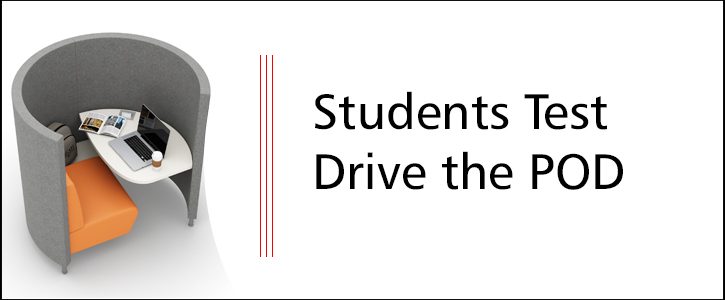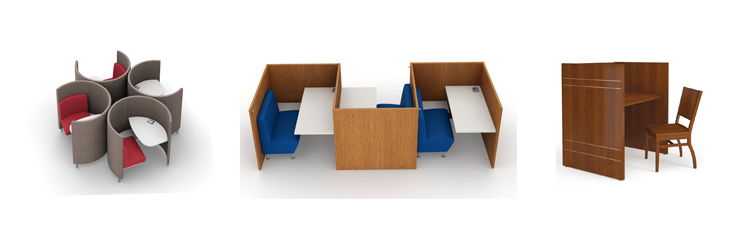
Every industry needs its experts and advocates, but sometimes commentary from the user can uncover the most eye-opening discoveries.
Late last year, two prominent universities, one on the East Coast and one on the West Coast, trialed The POD and Hampton NOOK. This helped AGATI learn not only how students engaged with the products, but also how the universities themselves could gain insight into student opinions on their library space.
As learning styles continue to evolve, the furniture in our academic libraries must take into consideration these transformations and create the most conducive spaces for student engagement — in studying and other library programming.
The Study Carrel Concept is Still “In”
Study carrels are not a long-forgotten piece of furniture stowed away in the stacks of libraries. They are used frequently by students looking to sit for an extended period of time and write papers or perform extended research. In fact, 70% of NOOK users and 70% of POD users responded that they use the study carrels in the library at least once a week. With this in mind, study carrels play a big role in modern libraries and we must adapt our carrels to new student work needs and patterns.
Actual Work Space is Valued
When library furniture was being designed a century ago, the concept of a laptop and likely a mobile device/earbuds combo occupying the work space wasn’t even a consideration. Today, a minimum comfortable working surface area is 32 inches by 26 inches. Data from the research at our two trial universities showed that 88% of NOOK users and 82% of POD users said they had sufficient space to work.
Where Libraries Beat Coffee Shops: Focus-ability
Students surveyed overwhelmingly commented that they choose to study in a library because it is reliably quiet and they can focus more easily.
Of course, libraries on campuses that host tens of thousands of students are not without distractions while people are bustling about as they research, write, and interact with friends and professors. A solution to giving students space to focus without building countless study rooms is to provide furniture pieces that have panels that are high enough to promote a sense of privacy, but not too tall that they give a feeling of isolation.
In our trial study, 88% of NOOK users and 82% of POD users found it quite easy to focus while studying (and both furniture pieces were placed in main library areas where traffic was existent).
Furniture That Meets Today’s Needs
The difference between the POD and Hampton NOOK. in comparison to a traditional study carrel lies in the direction of the seat related to the surrounding panel. Traditional carrels expose the back with surround panels on the sides and in front of users.
In contrast, The POD and Hampton NOOK turn the user 90 degrees, providing coverage not only in front and on the side, but also the back, relieving the instinctive insecurity that ensues when one’s back is exposed to the surroundings. At least 86% of students surveyed at our two trial universities say they’d prefer using a POD or Hampton NOOK, with their side entrances, over a traditional study carrel.
The Fun of Survey Comments
Like any survey, it is always interesting to read subjective comments. Here are some of our favorites:
- “I like the comfortable chair and the charger.”
- “I’m 6’4” with a ton of supplies and even I didn’t feel squished.”
- “The walls keep me focused.”
Do The POD and Hampton NOOK Have a Place in Your Library?
We love to talk about our furniture. In fact, we take things a step further and offer a free rendering of your space to see how these carrels will enhance your single-user study areas.

